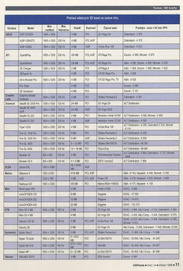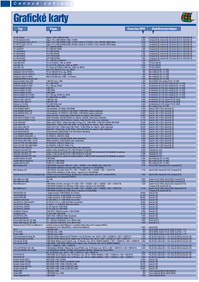Ok, so new findings with rage pro. I've spent last 2 days playing with and testing Rage Pro Turbos.
The core starts to be unstable past 79mhz. Sometimes, it handles 81 or 82, but on both rage pro turbos, I get strange mirroring vertical distortion. In every game I tested, GLquake, GLhexen2, MDK, and Tomb Raider 2. Memory works up to 115 though. Cannot get past 116 mhz on memories, seems VGA BIOS resets its to 60 mhz. (so basically halves it).
Not sure, why it is so, if it is driver related, or can be somehow prevented, but if not, Rage Pro is then pretty much not overclockable on core. You can get like 5 mhz above 75mhz. (one of my Rage Pro Turbo is already unstable on 79mhz thought).
But memories at 100mhz are quite enough, so you won't get much performance by overclocking it to 115 (I often not get even 5% of performance in real game scenarios)
Even more interesting is fact, that my 4MB Rage Pro Turbo is much slower than 8 MB Rage Pro Turbo.
I was testing it like 2 hours, but it's still there. The differance is remarkable. In GLQuake 640x480x16, 4 MB Rage Pro Turbo gets 16.7 fps. But 8MB Rage Pro Turbo gets 21.8 fps. What's going on there? Both versions are same (SGR memory, same Ati-109- code , just one is Ati Xpert@Work (without TV out) and one is Ati Xpert@Play.
In GLHexen2 , differance between two were even more remarkable. Like 10.5 fps vs 19 fps. (almost double for 8MB version).
But 4MB memory should be enough for 640x480x16.
I've tried to lower resolution to 400x300x16, to eliminate memory full scenario, but it does also here.
Interestingly enoigh, when I've raise up resolution to 800x600x16 for GLhexen2, Rage Pro Turbo 8 MB started to have same abbysmal FPS as Rage Pro Turbo 4 MB on lower resolutions. 10.5 fps. I'm starting to thinking, that it's because it's using AGP texturing memory (system memory). Because it's same fast, which points up to memory limitation problem. But that would mean, that 4 MB Rage Pro cannot handle even 400x300x16 which is very weird. Because without memory limitation, both Rage Pro (Xpert@play and Xpert@work) should be same fast (in various benchmarks in historical magazines, they have same values... even all-in-wonder pro has same values). But how it is possible, than 400x300x16 already has lowered FPS for 4MB version. Because it should handle GLquake (one of the oldest accelerated games , and least demanding on memory... 4 MB should be enough).
The only explanation should be, that 4 MB is not enough, because it needs also memory for 2D part of VGA (drawing the screen). And from 4MB , too little stays for textures etc... so it needs to use AGP aperture memory.
I will test it on another 4 MB Rage Pro (original version, without Turbo, that came out in 1997). Unfortunately, those had only SDR memories, not SGR memories.
All cards had 75 core and 100 memory, so it's not because different clocks.

